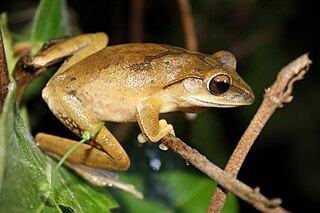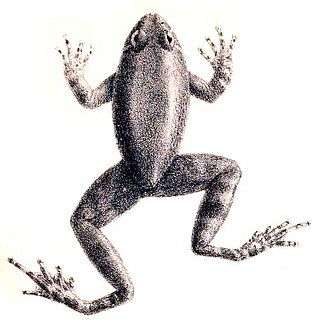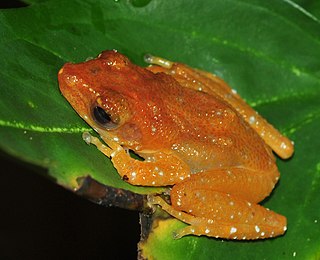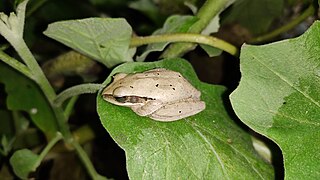
Polypedates is a genus of frogs in the family Rhacophoridae, the shrub frogs and Paleotropic tree frogs. They belong to subfamily Rhacophorinae. Members of this genus are collectively known as whipping frogs. They occur in eastern and southern Asia.

Polypedates megacephalus, the Hong Kong whipping frog or spot-legged tree frog, is a species in the shrub frog family (Rhacophoridae). In its native range, it is also called "brown tree frog", but this name is otherwise applied to a species of the true tree frog family (Hylidae).

Wallace's flying frog, also known as the gliding frog or the Abah River flying frog, is a moss frog found at least from the Malay Peninsula into western Indonesia, and is present in Borneo and Sumatra. It is named for the biologist, Alfred R. Wallace, who collected the first known specimen.

The seep frog or Balu oriental frog is a species of frog in the family Dicroglossidae. It is probably endemic to Borneo.

The common green frog is a frog species of in the true frog family Ranidae; some sources still use the old name Rana erythraea. It lives in Southeast Asia and is also known as green paddy frog, red-eared frog or leaf frog. The last name, however, commonly refers to the Neotropical tree frogs which make up the subfamily Phyllomedusinae. These are not closely related to H. erythraea, belonging to family Hylidae instead.

Nyctixalus pictus, also known as cinnamon frog, cinnamon treefrog, cinnamon bush frog, painted Indonesian treefrog, and white-spotted treefrog, etc., is a species of frog in the family Rhacophoridae. It is found in the Malay Peninsula, the Philippines, and parts of the Greater Sunda Islands.

Philautus hosii is a species of frog in the family Rhacophoridae. It is endemic to Borneo and has been found at 1,351 m (4,432 ft) above sea level. The specific name of the synonym, Polypedates chlorophthalmus, refers to its "remarkable green iris", from the Greek for "green-eyed". Accordingly, the common name green-eyed tree frog has been coined for the species.
Philautus ingeri is a species of frog in the family Rhacophoridae. The species is endemic to northern Borneo, where it is found in Sabah, Sarawak, Brunei, and adjacent northern Kalimantan (Indonesia). The common names Inger's bush frog and Inger's bubble-nest frog have been coined for it. It is named for Robert F. Inger, American zoologist from the Field Museum of Natural History.
Philautus mjobergi is a species of frog in the family Rhacophoridae. It is endemic to northern Borneo and found in Kalimantan (Indonesia) and Sarawak (Malaysia). The specific name mjobergi honours Eric Mjöberg, a Swedish naturalist, ethnographer, and explorer. Common names Murud bubble-nest frog and Mjöberg's bush frog have been coined for it.

Polypedates colletti is a species of frog in the family Rhacophoridae. It is found in the Malay Peninsula, southern Vietnam, Borneo, Sumatra, and islands of the South China Sea.

Polypedates cruciger is a species of frog in the family Rhacophoridae endemic to Sri Lanka. It has been osbserved as high as 1600 meters above sea level.

Polypedates leucomystax is a species in the shrub frog family Rhacophoridae. It is known under numerous common names, including common tree frog, four-lined tree frog, golden tree frog or striped tree frog. Many past authors have united it with the common Indian tree frog in P. maculatus, but today they are generally considered distinct species. In its native range, it is also called "white-lipped tree frog", but this name is otherwise applied to a species of true tree frogs.

Polypedates otilophus is a species of frog in the family Rhacophoridae. It is endemic to Borneo where it is widespread and found in Brunei, Indonesia, and Malaysia, typically in the lowlands but sometimes as high as 1,100 m (3,600 ft) above sea level. This species has prominent, sharp ridges behind the eye, above the ear, referred to in its names.
Leptomantis gauni is a species of frog in the family Rhacophoridae. It is endemic to Borneo and is found in Sabah and central Sarawak (Malaysia), Brunei, and north-eastern Kalimantan (Indonesia). The specific name gauni honours Gaun Sureng, a collector for the Sarawak Museum and a companion to Robert F. Inger on field trips when this species was observed. Common names short-nosed tree frog and Inger's flying frog have been coined for it.

Feihyla kajau, also known as the Dring's flying frog, white-eared tree frog, and white-eared jelly-nest frog, is a species of frog in the family Rhacophoridae. It is endemic to Borneo and found in all major jurisdictions of the island Kalimantan (Indonesia), Sabah and Sarawak (Malaysia), and Brunei. The specific name kajau is Berawan for "charming".

Polypedates himalayensis, the Himalayan tree frog, is a species of tree frog found in north-eastern India. It has been observed between 100 and 2000 meters above sea level.

Pulchrana baramica, the Baram River frog, brown marsh frog, or masked rough-sided frog, is a species of "true frog", family Ranidae. It is found in the Malay Peninsula, including the extreme south Thailand, Peninsular Malaysia, and Singapore, and in the Malay Archipelago, including Borneo, and the Indonesian islands Java, Sumatra, and Bangka Island. Its type locality is the Baram River in Sarawak, Malaysia, giving it one of its common names. Its natural habitats are tropical moist lowland forests and swamps. It is not considered threatened by the IUCN.
Polypedates pseudotilophus is a species of frogs in the family Rhacophoridae. It is endemic to Sumatra and Java in Indonesia, where it has been observed between 0 and 1000 meters above sea level.

Feihyla inexpectata is a species of frog in the family Rhacophoridae. This recently (2014) described species is endemic to Malaysian Borneo and known from its type locality in the Maliau Basin Conservation Area, Sandakan Division, Sabah and from Danum Valley, also in Sabah. Common name Bornean opposite-fingered tree frog has been coined for it.

Rhacophorus borneensis is a species of frog in the family Rhacophoridae. This recently (2013) described species is endemic to Malaysian Borneo where it is known from its type locality in the Maliau Basin Conservation Area, Sandakan Division, Sabah as well as from the Batang Ai National Park, Sarawak. Prior to its description, it was included in Rhacophorus reinwardtii. It is said to be "one of the prettiest frogs of Borneo". Common name Borneo flying frog has been coined for it.


















